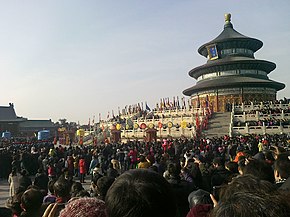Shangdi
In addition, it is commonly used by contemporary Chinese (both mainland and overseas) and by religious and secular groups in East Asia, as a name of a singular universal deity and as a non-religious translation for God in Abrahamic religions.
The conceptions of the Supreme Ruler (Shang Di) and of the Sublime Heavens (Chinese: 皇天; Wade–Giles: Huang-t'ien) afterward coalesce or absorb each other.
Shangdi was regarded as the ultimate spiritual power by the ruling elite of the Huaxia during the Shang dynasty: he was believed to control victory in battle,[1] success or failure of harvests,[1] weather[1] conditions such as the floods of the Yellow River, and the fate of the capital city[1] and kingdom.
Modern researches have paid attention to the adoption of Shang religious practices by the Zhou dynasty, and particularly, the continued worship of Shangdi through altered forms.
Evidence from oracle bone inscriptions show that the Shang believed in Shangdi's blessings for the king, which some scholars interpreted as a belief in the ruler's granted authority by the gods.
Likewise, the Shang's lesser houses, the shi knightly class, developed directly into the learned Confucian gentry and scholars who advised the Zhou rulers on courtly etiquette and ceremony.
One such situation appears in bronze castings during King Li of Zhou's reign (9th century BC),[24] pointing out the prevalence of equating both words with each other.
In some cases, "Di" still denoted a high deity with a distinguished charge over celestial objects, but in others it was written in collocation with other words, incorporating the connotation of "god" to those concerned.
In later eras, he was commonly known by the name "Heavenly Ruling Highest Deity" (皇天上帝, Huángtiān Shàngdì) and, in this usage, he is especially conflated with the Taoist Jade Emperor.
In Shang sources, Di is already described as the supreme ordainer of the events which occur in nature, such as wind, lightning and thunder, and in human affairs and politics.
[29] David Pankenier has studied the astral connections of Shangdi, drawing on a view that interest in the sky was a focal character of the religious practices of the Shang, but also of the earlier Xia and Erlitou cultures.
Pankenier argues that the supreme Di was identified with the celestial pole, an idea familiar in later stages of Chinese religion, linking with the Tàiyī 太一 ("Great One") fully documented as early as the 4th century BC.
The Shang probably deliberately identified their ancestor with a universal god recognized in different regions and local cultures in order to legitimize their power.
These gods represent Di's authority to exercise control over disastrous events, contrary to "friendly" Shang ancestral square.
[32][4][clarification needed] As mentioned above, sacrifices offered to Shangdi by the king are claimed by traditional Chinese histories to predate the Xia dynasty.
The surviving archaeological record shows that by the Shang, the shoulder blades of sacrificed oxen were used to send questions or communication through fire and smoke to the divine realm, a practice known as scapulimancy.
Under Shangdi or his later names, the deity received sacrifices from the ruler of China in every Chinese dynasty annually at a great Temple of Heaven in the imperial capital.
[clarification needed] The altar would have three tiers: the highest for Shangdi and the Son of Heaven; the second-highest for the sun and moon; and the lowest for the natural gods such as the stars, clouds, rain, wind, and thunder.
[34] It was during Ming and Qing dynasty, when Roman Catholicism was introduced by Jesuit Priest Matteo Ricci, that the idea of "Shangdi" started to be applied to the Christian conception of God.
[39] Ricci's translation also invited the displeasure of Dominicans and that of the Roman Curia: on March 19, 1715, Pope Clement XI released the Edict Ex Illa Die, stating that Catholics must use "Tianzhu" instead of "Shangdi" for Christianity's God.
A conference held in 1877 in Shanghai, discussing the translation-issue, also believed that "Shangdi" of Confucianism and the Christian concept of God are different in nature.
[43][44] Catholics preferred to avoid it, due to compromises with the local authority in order to do their missions, as well as fear such translation may associate the Christian God to Chinese polytheism.
[45] Nowadays, through the secular Chinese-language media, the Chinese word of "Shangdi" and "Tian" are frequently used to as a translation for the singular universal deity with minimal religious attachment to the Christian idea of God, while Confucians and intellectuals in contemporary mainland China and Taiwan attempt to realign the term to its original meaning.





